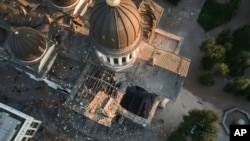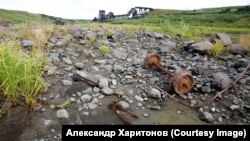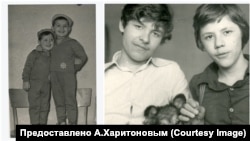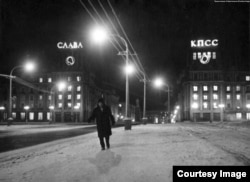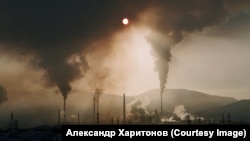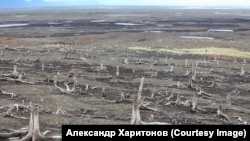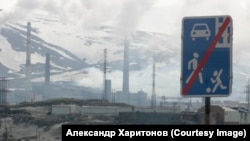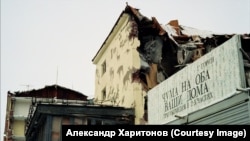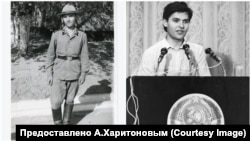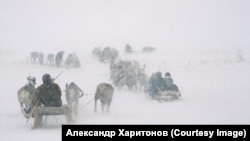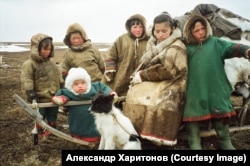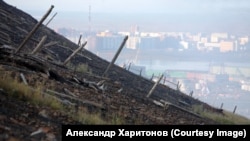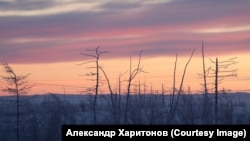One person was killed and 22 wounded, including four children, in fresh Russian missile strikes on the Ukrainian port city of Odesa, Ukrainian officials said on July 23. The Transfiguration Cathedral of the Moscow-linked Ukrainian Orthodox Church (UOC) was severely damaged in the attacks.
Photo Galleries
Monday 24 July 2023

NORILSK, Russia -- Photographer Aleksandr Kharitonov grew up in the remote Russian mining city of Norilsk, located above the Arctic Circle. His images of its landscapes, remnants of its Soviet past, and the strength of its people -- who must endure the hardships of living in isolation -- capture fleeting moments of a fast-changing world.
Kharitonov is a third-generation Norilsk citizen. After his grandfather served his term in a forced labor camp, he chose a rare path and decided to remain in Norilsk and moved his family there.
Norilsk was founded at the end of the 1920s, but the official date of the city's foundation is traditionally held to be 1935, when the gulag labor camp known as Norillag was established and prisoners began construction work on mining and metallurgical plants.
Today, Norilsk is home to roughly 180,000 people, though access is restricted and special permission must be obtained to visit.
Kharitonov's body of work encompasses nearly 55 years of photographs and stories. The following is his personal account of growing up and living in Norilsk.
Life As An Adventure
My first impression of Norilsk was that it was dark and cold, with huge snowdrifts. I remember the blizzards and the large snowflakes falling next to the streetlamps. There was more light and illuminated advertising in Norilsk than even in Moscow.
My brother and I viewed our new life in Norilsk as an adventure. Yes, there was very little greenery and those long days and long nights, but in the innocence of childhood, all of this was not perceived as something terrible.
To compensate for the lack of sunlight, we were given fish oil in kindergarten, which no one liked. But we walked a lot on the street and played hockey and football. It was a joyful childhood.
It was worse in the outer regions in terms of cuisine. Barges were used to transport potatoes, until they ran out in March and April. Eggs were in scarce supply and had to be airlifted in. There were cherries only once a year.
In the summer, half of Norilsk went to the forest to forage for mushrooms, blueberries, and lingonberries. Lingonberries -- similar to cranberries -- are an absolutely wonderful thing. I remember huge 5-liter jars of lingonberry jam prepared for the winter.
Venison was sold in stores, but it was of very poor quality. They would kill a deer, but they would not bleed it out, and the meat would turn black. Only hunters had good venison.
Fish was rarely available. Only those who caught it themselves could have northern fish. It was in the 1990s, with the advent of a market economy, that fish processing plants appeared in Norilsk, but during my childhood there was none.
I worked for several years -- before and after military service -- inside a copper plant. The temperature inside was 55 degrees Celsius, and you were inhaling toxic fumes. Many people developed rheumatism. In the smelter, the work was even more harmful and difficult.
The tundra is often a shade of muted brownish green due to Norilsk's copper plants, which release sulfur dioxide. The toxic gas blocks oxygen to the skin, the lungs, and plants. Mobile laboratories travel to Norilsk to monitor air quality, but for some reason, the reports they issue about excess concentrations do not specifically mention sulfur dioxide.
Due to the toxic emissions, the trees dried up and had to be cut down. The officials promised that, with the closure of the copper plants, the environment would recover. I would like to believe that.
As people are too lazy to clean up after themselves, they simply throw everything into the river. There was a year when the water in the Norilsk River dropped to a very low level, uncovering the waste. The rubbish was never removed; it only disappeared under the rising water.
Norilsk sits atop permafrost, and as it thaws, it creates cracks in the foundation of buildings, causing them to shift and collapse. Nearly 30 percent of the housing stock in Norilsk needs to be demolished due to this issue.
My military service consisted of a stint in Central Asia with a chemical unit. We can say we were lucky because, during the war in Afghanistan, chemical weapons were not used, and maybe that's why we weren't sent there.
In the late 1980s, I was forced to join the Communist Party and became the secretary of the Komsomol organization of the copper plant. This organization consisted of 350 people. I suggested to those who were just wasting time, or not participating, to leave the group. Afterward, I was expelled "for the collapse of the Komsomol organization."
After my departure from the factory and the collapse of the U.S.S.R., I worked for a musical cooperative. We brought records and CDs of foreign and domestic rock bands to Norilsk, and then live performers: Chaif, Time Machine, Sunday, BG, Dmitry Revyakin, Agatha Christie --the list is quite long. For Norilsk, hungry for contemporary music, this was a real breakthrough.
Our music company was attacked by cops and racketeers in the mid-1990s, which led to its demise.
A New Calling: With Camera And Pen
In the mid-1990s, having no journalistic or even higher education, I came to work for a local newspaper. I wrote about rock music and other topics. There were no taboo topics for us. I also wrote about waste and environmental issues. It was during these years when I focused on the community.
With the change in the political climate, a new editor came in and began to oppose our muckraking. One of my last articles was so emasculated that I took my name off of it and left the newspaper.
Capturing The Cultures Of Indigenous Peoples
At the turn of the century, I made several reportages on the Nenets, an indigenous group of people native to Russia's Far North, a people whose world was quickly changing. They still ride reindeer, but their reindeer herding and fishing is disappearing.
They were forced into collective farms. They found village life to be very difficult, with rampant crime, alcohol abuse, poverty, and a lack of communication with other indigenous people. Authorities are trying to help, but village life remains foreign to them.
The Gulags: Stalin's Legacy And The City That Slaves Built
According to the Norillag archives, over 16,000 prisoners died in exile in Norilsk as a result of forced labor, starvation, and intense cold during the years the camps were operational (1935–56). Fatalities were especially high during World War II, when food supplies were particularly scarce. An unknown number of prisoners continued to die until roughly 1979.
Saying Goodbye To The Tundra
On January 1, 2023, a friend and another photographer and I went to say goodbye to the tundra. We traveled only 8 kilometers from Norilsk. I could feel that Norilsk mood that I remembered from childhood with its colors and light -- a winter without the sun on a cold night.
But it's time for me to leave all of this behind. I have five children, four of whom have been living on the "mainland" for a long time, and I want to be with them.
I will not complain about my health, but with age, the polar days and polar nights become much harder to endure. There are also projects not related to Norilsk that I would like to take on.
Norilsk is a good place for tourists, but to live there…. I have always said that the north is against people living there. Man does not live there, but survives.




